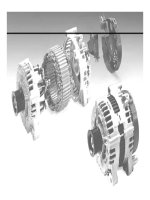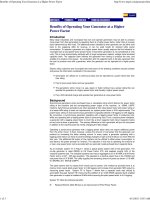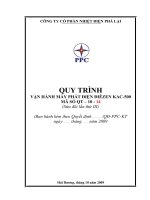CÁC LỢI ÍCH KHI VẬN HÀNH MÁY PHÁT Ở HỆ SỐ CÔNG SUẤT CAO (Benefits of operating your generator at a higher power factor )
Bạn đang xem bản rút gọn của tài liệu. Xem và tải ngay bản đầy đủ của tài liệu tại đây (137.95 KB, 3 trang )
Benefits of Operating Your Generator at a Higher
Power Factor
Introduction
Many large industrials and municipals that own and operate generation may be able to produce
more power from their generators by operating them at a higher power factor, rather than at a power
factor determined by their load. The additional power released by their generator can be either sold
back to the supplying utility for revenue, or can be used locally for reduced utility power
consumption. To operate a generator at a higher power factor usually requires that the industrial or
municipal have a load power factor (power factor of load when generation is not considered) of near
unity. This is most economically achieved with a large inexpensive medium voltage metal enclosed
capacitor bank. The capacitor bank relieves the generator from having to produce the vars, and
enables it to produce more power. Var production with the capacitor bank is far less expensive than
the cost to produce vars with a generator, when the generator can be operated at a higher power
factor.
Electric utility customers and municipals that meet some of the following conditions should consider
and pursue the information contained in this document.
Generators are utilized on a continuous basis and are operated at a power factor less than
their rating
Pay for poor power factor and own generation
The generators’ prime mover (i.e. gas, steam or hydro turbine) has a power rating that can
operate the generator at a higher power factor and thereby a higher power output.
Pay a KVA demand charge and operate their generators at a low power factor.
Background
Synchronous generators when purchased have a nameplate rating which defines the power factor
rating of the machine and the corresponding power output of the machine, i.e. 10MW, 0.85PF
machine. Synchronous generators are often operated at their rated power factor and power rating or
at a lesser MW rating to meet var requirements (or system power factor or KVA requirements). The
power factor rating of most synchronous generators is typically between 0.8 lagging to 0.95 lagging.
By convention, a synchronous generator operating with a lagging power factor is producing vars,
while one operating with a leading power factor is consuming vars. From a reactive power viewpoint,
a generator with a lagging power factor is much like a shunt capacitor bank (shunt capacitor banks
put out vars as does a generator). The primary difference is that a generator will put out real power
in addition to the reactive power by merely changing the field voltage.
Operating a synchronous generator with a lagging power factor does not require additional power
from the prime mover. It does, however, reduce the amount of real power that the generator can
produce by increasing the stator winding current. In many cases, a generator operating with a
lagging power factor can have its control settings changed or type so that it will put out more KW and
less vars. The additional kW output of the machine can be utilized to offset power consumption or
sold back to the power provider for revenue. The reduction in kvar due to operating the machine at
or near unity power factor can be provided with an automatic metal-enclosed shunt capacitor bank.
As an example, system "A" in Figure 1 shows a typical power system with on-site generation. The
on-site generator is rated 25MVA at 0.8 Power Factor (PF) and supplies roughly 53% of the
industrial systems load. The industrial systems load has an aggregate sum of 45 MVA at 0.84 Power
Factor and is a 24/7 - 365 day operation. This equates to a reactive power flow of 24.4 MVAR and
real power flow of 37.8 MW. The utility supplies the remaining amount of power as shown (17.8 MW,
9.4 MVARS, 20.1 MVA @ 0.88PF).
The plant owners wish to reduce their overall cost for power. One method as provided here is to
improve their overall plant power factor to 0.90 lagging and increase their generator MW output by
improving power factor. System "B" in Figure 1 shows how a capacitor bank was utilized to
accomplish this goal. System "B" shows that the addition of an 18.25 MVAR capacitor bank enabled
their generator to output an additional 5 MW while improving the plant power factor to 0.9 Lagging.
System "B" offers the following benefits:
Ø Reduced Electric Utility Bill due to an improvement of Plant Power Factor.
Benefits of Operating Your Generator at a Higher Power Factor />1 of 3 4/11/2013 10:53 AM
Ø Reduced Electric Utility Bill due to lower amount of purchased power from power provider.
In today's de-regulated market place, 5 MWATTS of power can equate to millions of dollars a year in
savings. Payback periods for the capacitor bank can be less than one month.
Figure 1 - Typical Power System with On-site Generation. The Figure Shows How The Realand
Reactive Power Flow Can be Changed For The Addition of a Capacitor Bank
Generator Capability
Every generator has its own capability curve and this information should be available
with the machine documentation or from the manufacturer. The capability curves define
the operating characteristics of the generator in terms of kW and KVar. A typical
synchronous generator reactive-capability curve, as shown in Figure 2, can be utilized
to determine the capability of a generator and whether additional KW can be obtained
from the generator. For example, the machine represented by the curve in Figure 2,
when operated at a lagging power factor of 0.8, will have a kW output of 0.8 per unit
and a kVAr output of 0.6 per unit.
Operating the same machine at unity power factor will result in a machine KW output of
1.0 Per Unit KVA and a kVAr output of 0.0 per unit. The required vars to offset the
generators reduction in var output (or rating of Medium Voltage Capacitor Bank) can be
calculated by simply subtracting the initial generator var output at the initial operating
point from the generators var output at the final or desired operating point.
Benefits of Operating Your Generator at a Higher Power Factor />2 of 3 4/11/2013 10:53 AM
Figure 2 –Typical Synchronous Generator
Reactive-Capability Curve
Conclusion
Power consumers that own synchronous generators can increase their revenue or save on their
electric power consumption by purchasing a shunt capacitor bank and changing their generators’
control settings. The ratings of the generators prime mover should be checked against the
generators capability curve to ensure it can operate at or near unity power factor. If it is determined
that the generator can operate at a higher power factor, a financial justification for the capacitor bank
that considers the following should be conducted.
The increased kW outputs of the synchronous generator will either reduce the amount of
power purchased from your electric power provider or it will increase the revenue obtained for
power that is sold to the power provider.
The capacitor bank can reduce utility bills by alleviating power factor penalties associated with
the purchase of power from the power provider.
Northeast Power Systems, Inc.
66 Carey Road
Queensbury, New York 12804
Phone: 518-792-4776
Fax: 518-792-5767
E-mail:
Website: www.nepsi.com
Copyright © 1999 - 2009
Northeast Power Systems, Inc.
Benefits of Operating Your Generator at a Higher Power Factor />3 of 3 4/11/2013 10:53 AM









